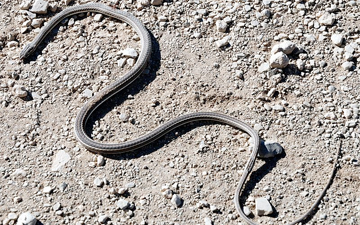The Dwarf whip snake can be identified by its large eyes, striped body and strictly diurnal lifestyle. It grows to an average length of 30 cm and a maximum length of 50 cm. [It is] found in Limpopo, Zimbabwe, Mozambique, Botswana, the Caprivi strip and Namibia. Its favoured habitat is moist savanna.
Its diet consists primarily of lizards and frogs, and in turn the Dwarf whip snake is eaten by birds of prey (particularly secretary birds and snake eagles) and other snakes.
(Adapted from Biodiversity Explorer, August 17th, 2010)
—
The colubridae family is by far the largest family of snakes within the squamata order of reptiles. By current classification, there are more than 2,000 members of the colubridae family. Snakes within this family are commonly referred to as colubrids.
Members of the Colubridae family of snakes are incredibly diverse. The colubrid snakes come in a wide variety of sizes, colors, and characteristics. Some colubrids are ground-dwellers while others are almost entirely arboreal. Some are aquatic while others are rarely found near bodies of water. Some primarily eat amphibians and fish, while others eat rodents. Some colubrids (like the kingsnake) eat other snakes, including venomous species.
(From Reptile Knowledge, August 17th, 2010)





